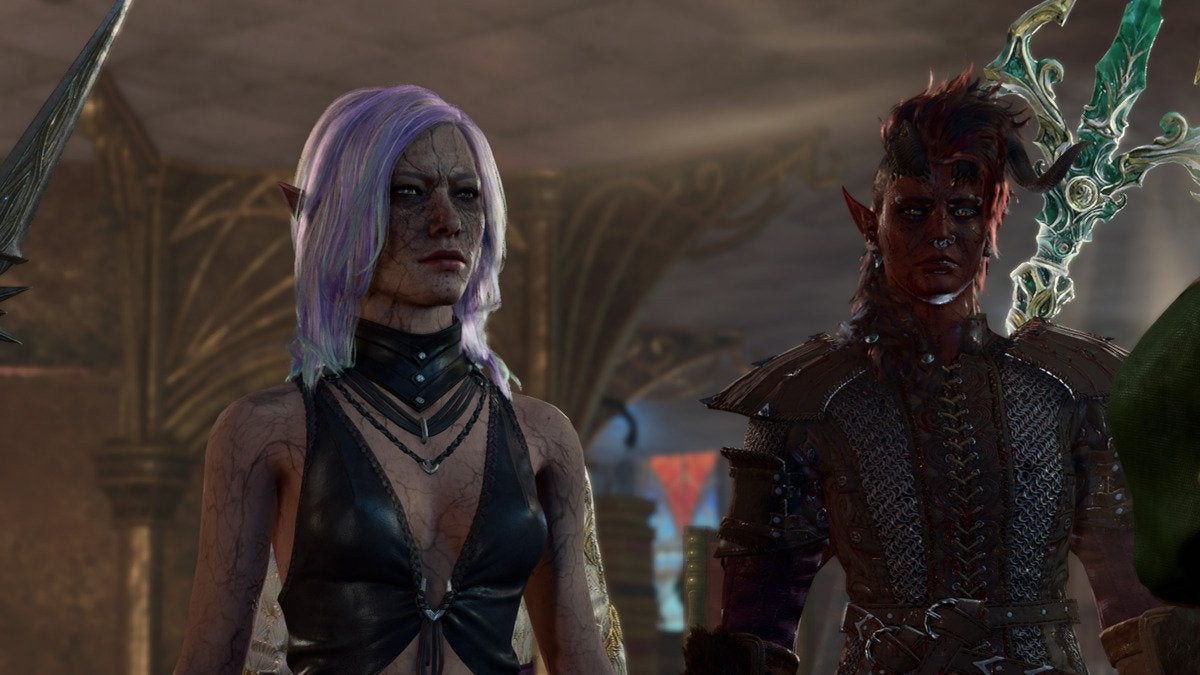![]() Key Takeaway
Key Takeaway
Much of the terminology used in Baldur’s Gate 3 is taken directly from Dungeons & Dragons. From methods of attack to general game mechanics, many new players may not be familiar with common terms found throughout the title.
If you’re familiar with the legendary tabletop RPG Dungeons & Dragons, the terminology found throughout Baldur’s Gate 3 will be familiar. However, newcomers may have a tough time understanding the sheer number of unique—and sometimes confusing—terms that appear during their adventures in the Forgotten Realms.
Table Of Contents
Ability Scores
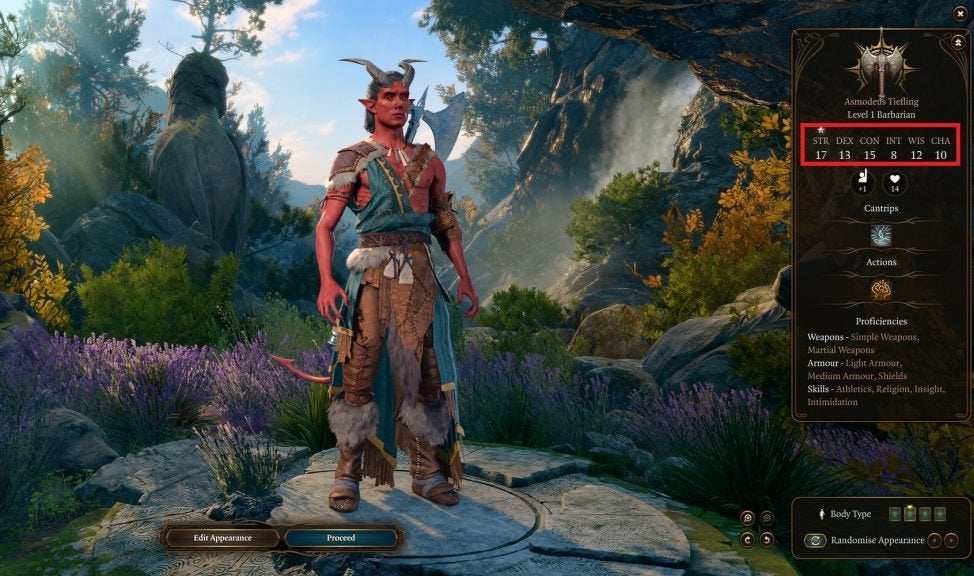
A character’s Ability Score is the numerical representation of one’s stats. The higher an Ability Score is in a given category, the better your character will be when using an action tied to that particular stat. For example, if your character has a high Ability Score in Strength, they will be more likely to land melee hits in combat.
There are six Ability Score categories, seen below:
Strength
This stat determines how likely you are to land a hit and how much damage your Strength-based weapon causes. It also impacts the distance you can jump and the weight you can carry. Strength Checks trigger when you do anything physically demanding, like trying to force open a door, lifting a heavy object, or keeping a boulder from rolling.
Dexterity
Dexterity influences how likely you are to land an attack on an enemy, your effectiveness with ranged weapons, and your Initiative. The higher your Dexterity, the more likely you’ll act first in battle.
Constitution
Your character’s Constitution impacts their overall HP, Stamina, and physical endurance.
Intelligence
Intelligence helps you wordlessly communicate with creatures, forge documents, find hidden objects, and improve memory. Wizards use Intelligence to determine whether or not their spells will hit.
Wisdom
Wisdom Checks trigger when your character needs to show awareness of what’s around them. This could be understanding someone’s feelings, noticing something strange about the environment, or reading body language. Clerics, Druids, and Rangers use Wisdom to determine whether or not their spells will hit.
Charisma
A Charisma Check may trigger when you attempt to entertain, manipulate, or influence someone. Additionally, Bards, Paladins, Sorcerers, and Warlocks use Charisma as their spellcasting ability to determine if their spells will meet their mark.
Ability Checks
A dice roll made to determine whether you succeed or fail at a task. Ability Checks are done by rolling a d20. If you roll the same or higher than the Difficulty Class shown, you succeed.
AC (Armor Class)
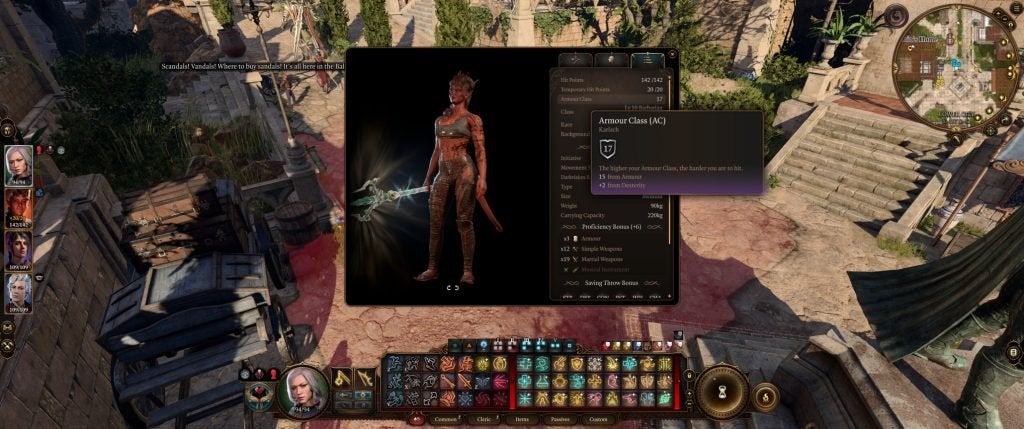
Arguably one of the most confusing for new players in terms of Baldur’s Gate 3 terminology, a character’s Armor Class is a measure of how well your character will avoid being wounded in battle. Your Armor Class can influenced by your armor, your shield, and your Dexterity.
For example, if your character wears Padded Armor, they are granted 11 AC. This means that an enemy must reach 11 during their Attack Roll to successfully hit you.
Actions
Actions are used when your characters can do anything in both combat and exploration. The Actions a character can perform depend on their Equipment and Class, and all characters can perform at least one Action and one Bonus action per turn. Certain Abilities can grant an additional Action.
Advantage
Having an Advantage allows a player to roll a second d20 during an Ability Check, Saving Throw, or Attack Roll. The higher roll determines the outcome.
An Advantage can be gained by:
- Attacking an enemy from higher ground
- Attacking an enemy that is Blinded, Entangled, or Paralyzed
- Attacking an enemy while hidden or invisible
- Attacking a Prone or Sleeping enemy within 1.5m
- Utilizing a Spell or Ability that grants Advantage
Armor Proficiencies
This mechanic determines which armor your character can wear. Wearing a type of armor that a character isn’t proficient in will grant a Disadvantage on all Ability Checks, Saving Throws, and Attack Rolls. It will also prevent spellcasting.
The three types of armor are Light Armor, Medium Armor, and Heavy Armor.
Armor Proficiency depends on a character’s class, but it is possible to gain new proficiencies by utilizing Feats or choosing a specific race or subclass.
Attack Roll
An Attack Roll occurs when a character attacks another character. The attacking character rolls a d20. If the roll is equal to or higher than the target’s Armor Class, the attack or spell is successful.
Background
This is a character’s lore. It determines who a player’s character was before the events of Baldur’s Gate 3 and impacts how other characters interact with them. There are 11 unique Backgrounds to choose from, and any Race and Class can select any Background.
Backgrounds also determine a character’s two Skill Proficiencies. For example, a character with a Criminal Background will excel in Deception and Stealth.
Bonus Action
This is a type of Special Action allowing a character to take an additional action on their turn.
Cantrip
Cantrips are the simplest form of magic. Although weaker than most forms of magic, these spells require no resources and can be used indefinitely.
Concentration
This bit of terminology is a common skill mechanic that is particularly important for magic users in Baldur’s Gate 3. Certain long-lasting spells require Concentration to cast, and if Concentration is broken, the spell’s effects will wane. Concentration can be broken by casting another Concentration spell, taking damage, or falling in combat.
Spells also have a set time limit and will fall off on their own in a specific amount of turns, or after a Long Rest.
Critical Miss
A Critical Miss occurs when rolling a 1 on a d20 during an Attack Roll. This means that you have failed spectacularly, and there is no way to completely avoid this outcome during your adventure.
Critical Hit
The opposite of a Critical Miss, a Critical Hit happens when rolling a 20 on a d20 during an Attack Roll. This means your attack will land, regardless of any modifiers or the target’s Armor Class.
Damage Types
In Baldur’s Gate 3, each attack has a corresponding damage type. Creatures may have specific Vulnerabilities or Resistances that can impact how much damage is dealt.
Damage Types include:
- Bludgeoning
- Piercing
- Slashing
- Acid
- Cold
- Fire
- Force
- Lightning
- Necrotic
- Poison
- Psychic
- Radiant
- Thunder
DC (Difficulty Class)
Difficulty Class is a number that must be matched or exceeded to be successful when rolling for an Ability Check or a Saving Throw. For example, if the Difficulty Class of an Ability Check is 10, you need to roll a 10 or higher to succeed.
Disadvantage
This is the opposite of Advantage. When rolling two d20s during an Ability Check, Saving Throw, or Attack Roll, the lowest roll determines the outcome.
A Disadvantage is gained by:
- Attacking an invisible enemy or one obscured by darkness
- Using a shield or wearing armor you aren’t proficient in
- Attacking an enemy from lower ground
- Being Blinded, Poisoned, or Frightened
- Making a ranged attack at an enemy in melee distance
- Attacking an enemy beyond 18m away
- Being hit with a Spell or Ability that grants Disadvantage
Feat
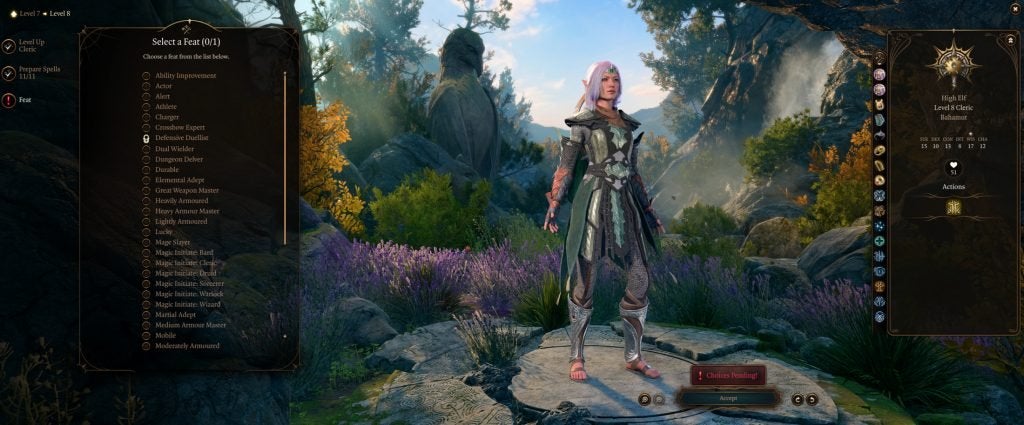
There’s a total of 42 unique stat bonuses, capabilities, and passive talents available at Level 4, Level 8, and Level 12—all of these are known as Feats. Only one Feat may be chosen upon reaching each of these three levels, and their effects are permanent. Feats are available to all characters regardless of their Class or Race.
High Ground
In battle, High Ground can be attained by positioning a character on top of hills, ledges, and other high terrain. When hitting an enemy from High Ground, a character gains a +2 bonus to ranged Attack Rolls. Enemies attempting to attack a creature with High Ground from a lower vantage point receive a -2 penalty.
Hit Dice
This determines a character’s maximum HP at Level 1.
The player’s Constitution modifier is added to the maximum value of their Hit Die to determine this figure. For example, a character with a d6 Hit Die and a Constitution modifier of +3 will begin with 9 HP at Level 1.
The number of Hit Points a character gains per level depends on their class, as different classes utilize different Hit Die. More physically powerful classes like Barbarians and Fighters have higher Hit Dice values, while less combat-inclined classes like Wizards and Sorcerers have lower Hit Dice values.
| Class | Hit Die |
|---|---|
| Barbarian | d12 |
| Bard | d8 |
| Cleric | d8 |
| Druid | d8 |
| Fighter | d10 |
| Ranger | d10 |
| Rogue | d8 |
| Paladin | d10 |
| Sorcerer | d6 |
| Warlock | d8 |
| Wizard | d6 |
Immunity
Immunity allows a creature or object to completely negate damage of a specific type. Immunities can be granted by certain items, Abilities, or Spells.
Initiative
This determines the order of turns during combat. At the start of a battle, all participants roll a d4 and add any Dexterity Modifiers to determine who goes first. The higher the result, the sooner a character can act in the turn order.
Inspiration
When an Ability Check is failed, Inspiration can be used to reroll. Inspiration Points are gained by completing specific actions that are in line with a character’s Background. A maximum of four Inspiration Points can be held at one time and they are shared between all characters.
Multiclassing
Multiclassing is the ability to mix and match different classes together in order to further customize and strengthen a character. This becomes available at Level 2, and any two classes can be chosen, regardless of how fitting they may be together. Particular classes complement each other, such as Paladin/Cleric and Bard/Rogue.
Multiclassing is completely optional and players can respec or remove their multiclass from their characters by speaking with Withers in Camp.
Opportunity Attack
The ability to attack an enemy moving out of your reach is called an Opportunity Attack. This can only be launched once per turn, and you will be asked whether or not you would like to strike once the right conditions apply.
Reactions
A Reaction is any attack and ability that is automatically triggered upon meeting specific conditions during combat. Some are class-specific while others can be used by all characters. Reactions can be toggled on and off.
Resistance
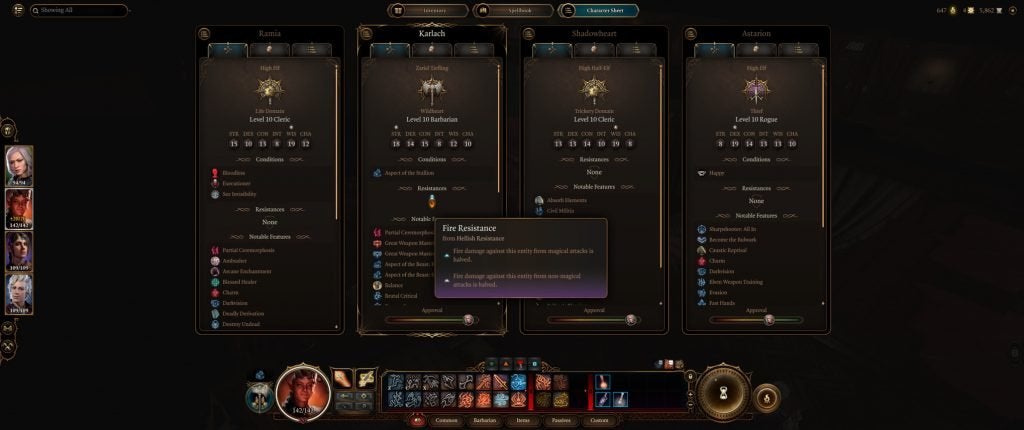
This allows a creature or object to take half damage from a certain attack type. Resistance can be granted by certain items, Abilities, or Spells, and all Dragonborn characters automatically gain Resistance to a specific element depending on their Subrace.
Tav
This is the default character name in Baldur’s Gate 3—which is less of a factor in terminology as it is some real-world lore. Swen Vincke, the founder and CEO of Larian Studios, chose the name as a shoutout to his dog, Gustav.
Saving Throw
A Saving Throw is a passive roll made to protect your characters from certain effects or actions, such as spells, physical attacks, traps, poisoning, and certain story instances. Characters are automatically granted proficiency in two Saving Throws depending on their class.
Short Rest/Long Rest
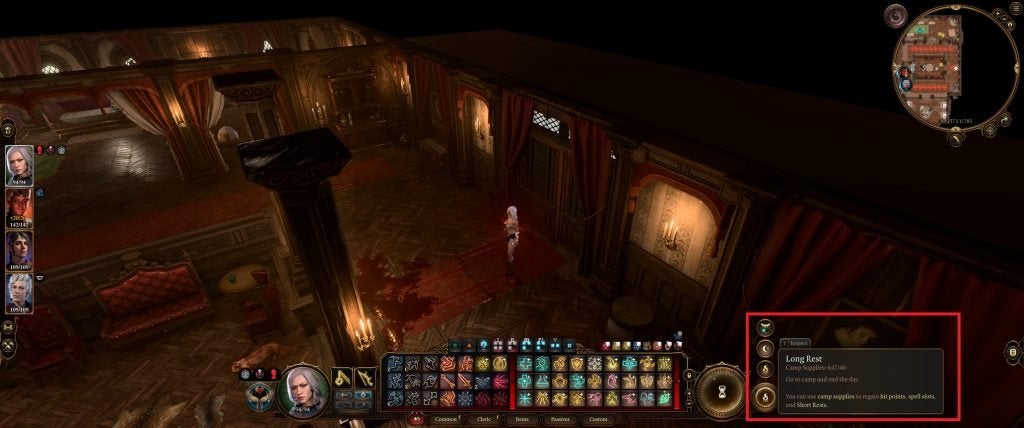
A Short Rest can be used when not in combat to recharge certain expended Abilities, Weapon Actions, and to recover HP. This can only be done twice per day, and a Long Rest will reset the cooldown period.
A Long Rest will fully heal the party and recover all Class Actions, Item Actions, and Spell Slots. This will also finish the day and can often trigger interactions with Companions that will progress their story arcs. To trigger a Long Rest, you must use 40 Supplies/Food, which can be looted as you explore.
Spell Slots
These are charges that get consumed each time a magic user casts a spell. The number of Charges available depends on the character’s Class. More powerful Spells require more Spell Slots to cast. You can think of this bit of Baldur’s Gate 3 terminology as ammunition for your spells.
Skill Proficiencies
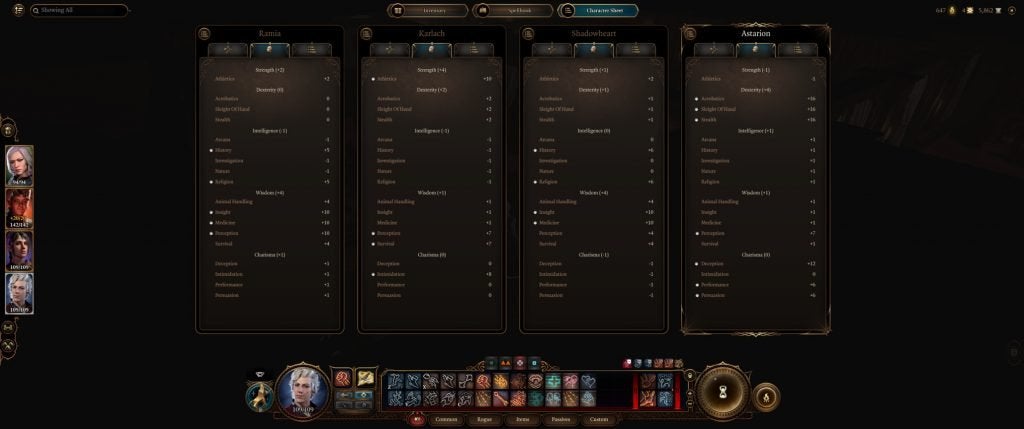
A Skill Proficiency is a passive bonus added to your character’s dice rolls that boosts your chance of passing the corresponding check. For example, if you’d like to pickpocket someone and must roll a 12 to do so, being proficient in Sleight of Hand will give you a +2 bonus.
There are 18 Skills in Baldur’s Gate 3, which are explained below:
| Skill | Description |
|---|---|
| Deception | Lie and cheat. Manipulate the truth. |
| Intimidation | Be a bully. Threaten and induce fear. |
| Performance | Entertain audiences. Command the stage. |
| Persuasion | Turn on the charm. Coax and cajole. |
| Acrobatics | Keep your balance. Land on your feet. |
| Sleight of Hand | Wield nimble fingers. Steal stuff. |
| Stealth | Stay out of sight. Melt into the shadows. |
| Arcana | Recognize magic. Interact with enchanted items. |
| History | Remember the past—of the world and its people. |
| Investigation | Analyze clues. Solve mysteries. |
| Nature | Recognize plants and animals. Hug trees. |
| Religion | Recognize deities. Understand holy rites. |
| Athletics | Stay fit. Perform physical stunts. |
| Animal Handling | Influence animals. Pet all of the dogs. |
| Insight | Read people and situations. Detect lies. |
| Medicine | Recognize symptoms. Diagnose disease. |
| Perception | Observe your environment. Spot hidden details. |
| Survival | Stay alive in the wild. Track prey. |
Trait
A Trait is any aspect of a character granted by their race and subrace. For example, all Githyanki are proficient with Medium Armor, while Elves and Dwarves can see in the dark.
Vulnerability
If a creature or object has a Vulnerability to a specific type of damage, damage of that type is doubled against it.
Understanding the unique terminology of Dungeons & Dragons is key to a successful Baldur’s Gate 3 playthrough. While it may take time to commit the above information to memory, exploring the Forgotten Realms with more comprehension will enrich your experience and make it easier to find victory against the Absolute.


